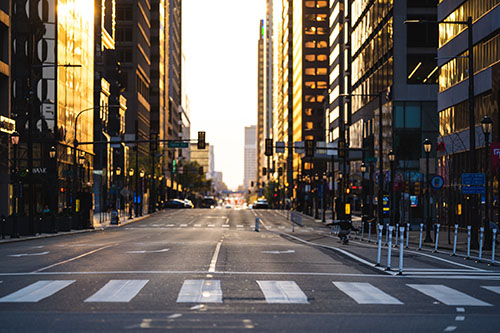With coronavirus mitigation efforts across the globe, we’ve all likely by now seen the social media posts of a clear Los Angeles skyline without smog or satellite images of the I-95 corridor with dramatic reductions in pollution. And while you can’t believe everything you see on the internet, it is likely that some places are experiencing immediate environmental effects of COVID-19 mitigation efforts. Here in Pennsylvania, we must be careful to consider more factors than simply comparing before and after pictures on Facebook or Instagram.
Since Governor Tom Wolf’s Stay-at-Home orders went into effect last month, one thing is obvious: behavioral business as usual has been upended and people are driving less. While it may be easy to think in terms of simple cause and effect, we must be careful to also consider other, less obvious variables when comparing emission data sets. For example, fewer cars on the road easily translates to fewer sources of pollution and lower levels of pollutants such as NO2, however NO2 levels are also almost always impacted by things like cloud cover, storms, and atmospheric pressure. Fewer cars, especially during peak times such as rush hour, is closely tied to COVID measures, but it is important to remember that myriad other factors must also be considered prior to reaching conclusions about the direct and immediate impact these measures are having on our local environment. Other factors to consider include the time of year, weather, cloud cover, improvements at power plants, new technology, and already downward sloping trends due to smart policy implementation.

PennDOT’s traffic monitors show that urban traffic has been greatly reduced over the past several weeks. Some pollutants, such as NO2, are more directly impacted by individual behaviors such as driving a car. If several thousand cars are removed from roadways each day, a subsequent reduction in NO2 levels would be expected. Other pollutants, such as SO2 or PM2.5, are more closely associated with stationary sources such as power plants and are less likely to show changes strictly related to COVID mitigation efforts. PM2.5 has already been declining with SO2 because of improvements at power plants and not because of behavior changes related to COVID.
We don’t have to wait for another major disruption to society to rethink business as usual. Through smart policy and individual behavior changes, we can all strive for lasting air quality improvements. Some of these changes can be every day lifestyle adjustments, such as less driving, more trip linking, and more public transportation, while others are policy driven, such as changes at power plants or transitions to cleaner energy.